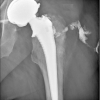One-Stage Exchange Arthroplasty for Fistulizing Periprosthetic Joint Infection of the Hip: An Effective Strategy
- PMID: 33178708
- PMCID: PMC7596676
- DOI: 10.3389/fmed.2020.540929
One-Stage Exchange Arthroplasty for Fistulizing Periprosthetic Joint Infection of the Hip: An Effective Strategy
Abstract
Background: Prosthetic hip infection (PHI) is a disastrous scenario after an arthroplasty. International guidelines contraindicate one-stage exchange arthroplasty for fistulizing chronic prosthetic hip infection (FCPHI), nevertheless few surgical teams, mostly from Europe, support one stage procedure for this indication. Questions/Purposes: Analysis of infection recurrence and implant failure of a series of FCPHIs treated with one stage arthroplasty. Patients and Methods: Sixty-six FCPHIs treated with one-stage exchange arthroplasty were prospectively followed up at least 2 years. Clinical, radiological and bacteriological signs suggestive of reinfection were sought, as well as implant failures and PHI related deaths. Results: Thirty-four females and thirty-two males with median age of 69.5 years [61-77] and BMI of 26 kg/m2 [22-31] were included. Fistulae were productive in 50 patients (76%). Staphylococcus was responsible for 45% of PHI and 21% were polymicrobial. Twenty-nine patients (44%) received preoperative antibiotic therapy. After a median 60-month follow-up [35-82], 3 patients (4.5%) presented reinfection (two new infections, one relapse) and 3 patients experienced implant failure (1 femoral fracture, 1 stem breakage, 1 recurrent dislocation). One death was related to PHI. After a minimum of 2 years, the infection control rate was of 95.3% (±0.02). Conclusion: One-stage exchange arthroplasty for FCPHIs showed a good infection control rate similar to that of non-fistulizing PHI. Systematic preoperative microbiological documentation with joint aspiration and, in some specific cases, the use of preoperative antibiotic therapy are among the optimizations accounting for the success of the one-stage arthroplasty. In light of these results, and those of other studies, international recommendations could evolve. Level of Evidence: Descriptive therapeutic prospective cohort study. Level of evidence: IV.
Keywords: fistula; hip; infection; joint; one stage exchange arthroplasty; prostheses.
Copyright © 2020 Marmor, Kerroumi, Meyssonnier, Lhotellier, Mouton, Graff and Zeller.
Figures
Similar articles
-
One-stage exchange arthroplasty for chronic periprosthetic hip infection: results of a large prospective cohort study.J Bone Joint Surg Am. 2014 Jan 1;96(1):e1. doi: 10.2106/JBJS.L.01451. J Bone Joint Surg Am. 2014. PMID: 24382729
-
Long-Term Results of a 2-Stage Exchange Protocol for Periprosthetic Joint Infection Following Total Hip Arthroplasty in 164 Hips.J Bone Joint Surg Am. 2019 Jan 2;101(1):74-84. doi: 10.2106/JBJS.17.01103. J Bone Joint Surg Am. 2019. PMID: 30601418
-
An often-unrecognized entity as cause of recurrent infection after successfully treated two-stage exchange arthroplasty: hematogenous infection.Arch Orthop Trauma Surg. 2018 Sep;138(9):1199-1206. doi: 10.1007/s00402-018-2972-3. Epub 2018 Jun 5. Arch Orthop Trauma Surg. 2018. PMID: 29868943
-
Indications for a single-stage exchange arthroplasty for chronic prosthetic joint infection: a systematic review.Bone Joint J. 2019 Jan;101-B(1_Supple_A):19-24. doi: 10.1302/0301-620X.101B1.BJJ-2018-0374.R1. Bone Joint J. 2019. PMID: 30648487
-
Partial two-stage exchange at the site of periprosthetic hip joint infections.Arch Orthop Trauma Surg. 2019 Jun;139(6):869-876. doi: 10.1007/s00402-019-03180-0. Epub 2019 Mar 29. Arch Orthop Trauma Surg. 2019. PMID: 30927063
Cited by
-
One-stage revision for infected shoulder arthroplasty: prospective, observational study of 37 patients.JSES Int. 2023 Jul 24;7(6):2433-2439. doi: 10.1016/j.jseint.2023.06.021. eCollection 2023 Nov. JSES Int. 2023. PMID: 37969534 Free PMC article.
-
Mid-term Results of 1-stage Revision Total Knee Arthroplasty for Periprosthetic Joint Infection With a Sinus Tract.HSS J. 2025 Feb;21(1):35-41. doi: 10.1177/15563316241228267. Epub 2024 Feb 7. HSS J. 2025. PMID: 39564405 Free PMC article.
-
Comparable clinical outcomes of culture-negative and culture-positive periprosthetic joint infections: a systematic review and meta-analysis.J Orthop Surg Res. 2023 Mar 16;18(1):210. doi: 10.1186/s13018-023-03692-x. J Orthop Surg Res. 2023. PMID: 36927390 Free PMC article.
-
Comment on Lunz et al. Impact and Modification of the New PJI-TNM Classification for Periprosthetic Joint Infections. J. Clin. Med. 2023, 12, 1262.J Clin Med. 2023 Sep 20;12(18):6073. doi: 10.3390/jcm12186073. J Clin Med. 2023. PMID: 37763013 Free PMC article.
-
Micromonas micros Infection of a Prosthetic Hip Joint: A Case Report and Review of the Literature.Case Rep Infect Dis. 2021 Sep 20;2021:9042790. doi: 10.1155/2021/9042790. eCollection 2021. Case Rep Infect Dis. 2021. PMID: 34589242 Free PMC article.
References
-
- Svensson K, Rolfson O, Kärrholm J, Mohaddes M. Similar risk of re-revision in patients after one- or two-stage surgical revision of infected total hip arthroplasty: an analysis of revisions in the Swedish hip arthroplasty register 1979–2015. J Clin Med. (2019) 8:485. 10.3390/jcm8040485 - DOI - PMC - PubMed
-
- Fernand N, Foguet P, Mont MA, Sodhi N, Molloy R, Saldaña R. What are the potential advantages of a one-stage exchange arthroplasty? International consensus meeting (icm) on orthopaedic infections. (2018). Available online at: https://icmphilly.com/questions/what-are-the-potential-advantages-of-a-o... (accessed 2020).
LinkOut - more resources
Full Text Sources



